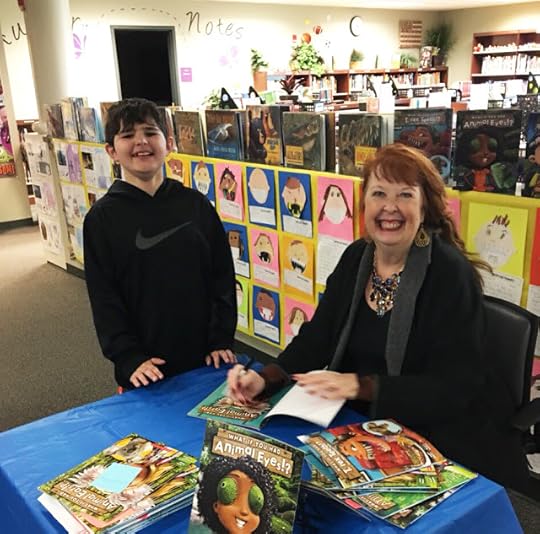Sandra Markle's Blog, page 14
January 8, 2020
SCHOOL VISIT TIME COMING UP!

I'm packing! Getting all ready!
It won't be long before I head out for lots of fun school visits.Here's where you'll see me.
Charleston, SC. January 27, 28, 29
Cincinnati, OH February 3, 4, 5, 6
Raleigh, NC February 10, 11, 12
Longview, TX February 20, 21
Atlanta, GA February 24, 25, 26
Bensenville, IL March 26, 27
Rosenberg, TX April 2, 3
Union Spring, NY April 30, May 1, 2
WE'RE GOING TO HAVE A BLAST TOGETHER!

Published on January 08, 2020 16:31
January 3, 2020
WHAT IF YOU HAD 2020 ANIMAL VISION!?
 It's the year 2020 so, at least for fun, it's the year of perfect vision.
It's the year 2020 so, at least for fun, it's the year of perfect vision.Enjoy these activities created by educators, teachers, and ME to spy some fun.

Is it better to have 2 eyes?

Click this link to FIND OUT!*prepared by the California Academy of Sciences
How Do Some Animals See in the Dark?

Click this link for an activity to SEE FOR YOURSELF!*Skip over any sign-up boxes
How Do Animals See Colors?
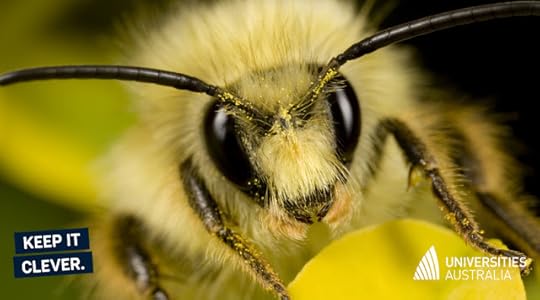 Bees have eye parts to see yellow, blue and ultraviolet light (UV)--wavelengths people can't see. To get what this looks like, draw 2 identical flowers. Color one the way people see it--so just as it looks to you. Color the other one the way a bee would see it with its ultraviolet light vision. Here is an example.
Bees have eye parts to see yellow, blue and ultraviolet light (UV)--wavelengths people can't see. To get what this looks like, draw 2 identical flowers. Color one the way people see it--so just as it looks to you. Color the other one the way a bee would see it with its ultraviolet light vision. Here is an example. 
Marsh Marigold people (Left) Marsh Marigold bees (Right)

Researchers now believe dogs do see color--blues and yellows but not reds. Try coloring a picture of your face the way a pet dog would probably see you.
Click this link for more animal color vision SNEAK PEEKS!
What animal has the weirdest eyes?

Take a look at these and PICK YOUR #1!
Next, search to find out more about that animal's eyes and vision. Then imagine yourself with that animal's eyes. What totally cool thing could you do with those animal eyes?!Here are 2 possibilities:Tarsier Eyes
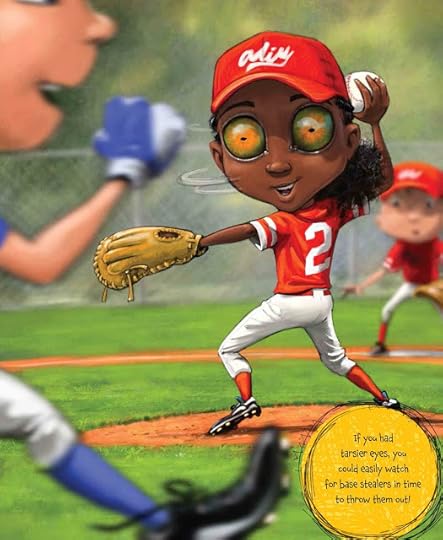
Four-Eyed Fish Eyes
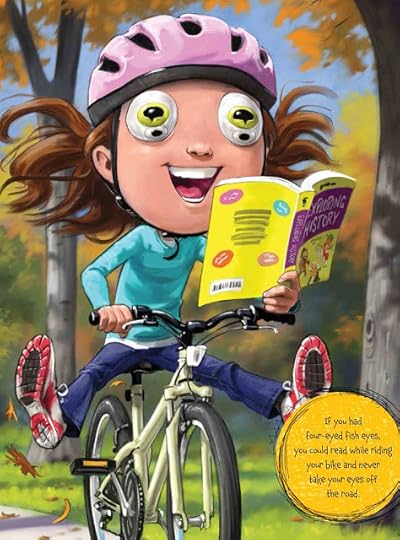
And
Watch Scholastic Book Fairs for the brand new WHAT IF YOU COULD!? series launch.

Published on January 03, 2020 06:50
December 15, 2019
HAPPY ARACHNID HOLIDAYS!
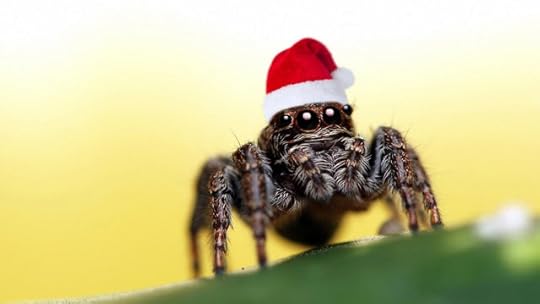
Okay, here it is--the 2019 edition of
THE TWELVE ARACHNIDS OF CHRISTMAS!
Don't miss this video!
https://www.youtube.com/watch?v=HYFQQB9vqPw
FIRST, did you know that spiders are the reason it's traditional to put tinsel on trees?
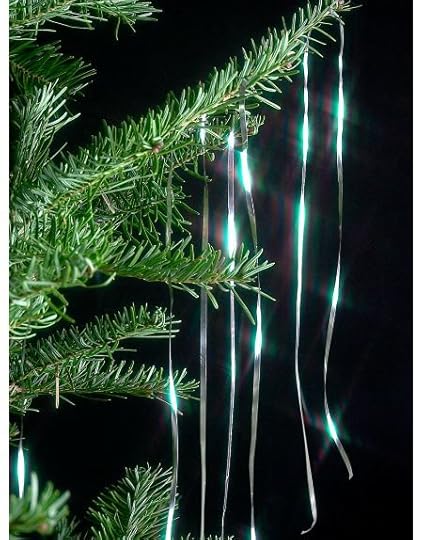
According to the legend, a long time ago in Germany a mother was cleaning the house for Christmas. All the spiders ran away to the attic to stay safe. But that night they came back downstairs. There, they discovered the Christmas tree all decorated with gleaming balls.
The spiders were so excited, they scurried up and down the tree, checking out everything. And the spiders covered the beautiful tree with gray webs.
When Santa arrived with gifts, he saw how happy the spinning spiders were. But he knew how sad the children would be to see their web-covered tree. So he touched the tree and the gray webs changed into silver strands.
That's how tinsel came to be...and why every Christmas tree should have a spider in its branches (at least an ornamental spider).
NOW, it's time for the discovery fun and smiles
inspired by my twelve book series: Arachnid World published by Lerner Publishing.
ENJOY!
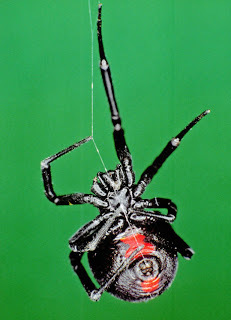
On the first day of Christmas, my true love gave to me a black widow in a fir tree.
On the second day of Christmas, my true love gave to me two striped bark scorpions courting with a dance.

There are sure to be baby scorpions in the new year.
On the third day of Christmas, my true love gave to me three wolf spiders.
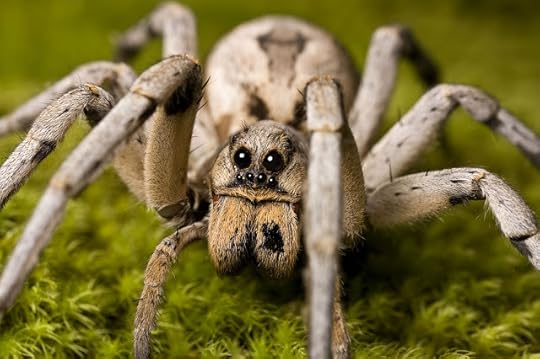

One was already a new mother with babies riding on her back.
On the fourth day of Christmas, my true love gave to me four wind scorpions.
Almost at once, one of the wind scorpions ran straight up a nearly vertical rock. How did it keep from falling off? A wind scorpion has sticky tips on its pedipalps, those long parts you can see stretching beyond its head.

Santa could use those to climb up the chimney after delivering presents!
On the fifth day of Christmas, my true love gave to me five hairy tarantulas.
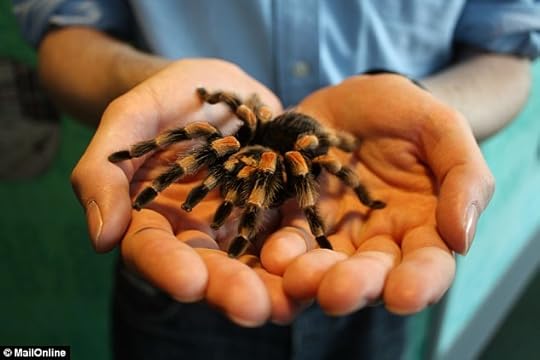
One really would have been enough!

On the sixth day of Christmas, my true love gave to me six female cross spiders spinning.
They were catching insect snacks.

So, in a way, they were wrapping up presents for later.
Doesn't that just put you in the holiday dinner mood!
On the seventh day of Christmas, my true love gave to me seven fishing spiders.
At just that moment, a bat flew past and all the fishing spiders dived down underwater.

When a fishing spider dives a layer of air coats its body. The spider is able to draw oxygen from the air-filled coat into its book lungs. The spiders stayed down for nearly thirty minutes to be sure to stay safe.
And, while they were waiting to safely surface, I'm sure they were making their Christmas wish list.
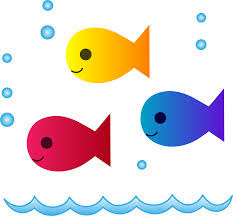
One little fishy for dinner. Two little fishies for dinner.Three little fishies for dinner.AND MORE!

On the eighth day of Christmas, my true love gave to me eight crab spiders lurking
inside flowers.
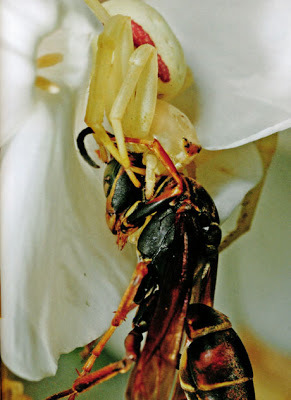
It takes about a week for the spider to change color. But inside white flower these turned beautifully snow white for Christmas.
On the ninth day of Christmas, my true love gave to me nine bobbing harvestmen.
Why were these spiders bobbing?
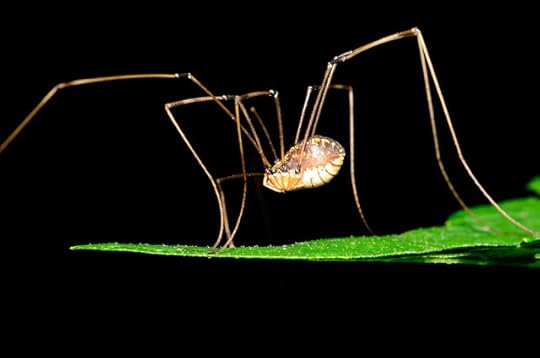
Harvestmen bob in a group when a predator, like a bird, is nearby. That way they look like a bigger animal--hopefully too big to eat.
Of course, I like to think they're really bobbing in time to a Christmas carol they're humming.
On the tenth day of Christmas, my true love gave to me ten ticks-a-sucking blood
from their host.
Female dog ticks can swell up until they were nearly six hundred times bigger.
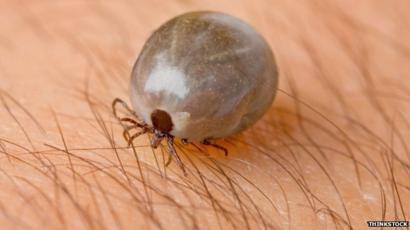
And once they were big, the ticks were ready to jiggle just like Santa's big belly when he laughs,
HO! HO! HO!
On the eleventh day of Christmas, my true love gave to me eleven jumping spiders jumping.
One leapt to catch its dinner.
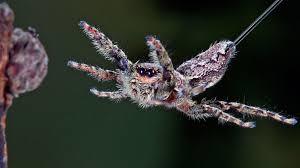
Some have been recorded leaping 40 times their own body length.
Oh, those spiders would be perfect for pulling Spider Santa's sleigh!
On the twelfth day of Christmas, my true love gave to me a plant with twelve mites-a-multiplying.

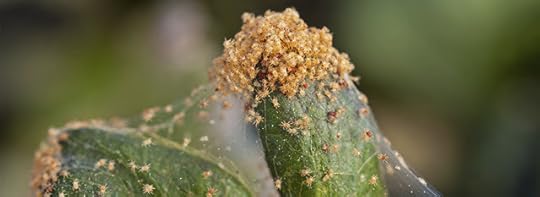
Each of the twelve mites was a female and they laid about 10 eggs a day. Soon the young hatched, became adults, mated and the new females started laying eggs too.
So the twelve became a zillion in no time at all.
One thing for sure, I'll definitely never forget that Christmas, when I received:
12 mites a-multiplying11 jumping spiders jumping10 ticks sucking9 harvestmen bobbing8 crab spiders lurking
7 fishing spiders fishing6 orb weavers spinning5 HAIRY TARANTULAS4 wind scorpions3 wolf spiders2 scorpionsAnd a black widow in a fir tree
As he drove out of sight, Spider Claus spun a silk web with a message of cheer... "Merry Christmas to all and may you have a very Happy New Year!"
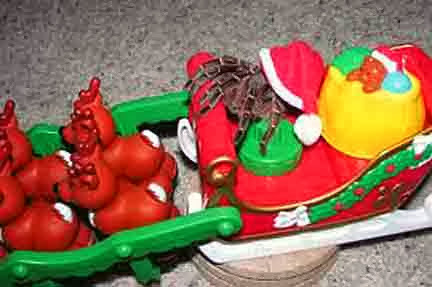
Published on December 15, 2019 12:03
November 27, 2019
FROSTY FUN!

I grew up in northern Ohio and I've been to Antarctica so I KNOW SNOW!
If you live where winter is snowy, here are some ways to explore and have fun.
Start with a winter scavenger hunt. Go outdoors and try to find one item for each category listed below. No fair using the same item for more than one category. This is great fun for groups to compete.
 You might find maple seeds like these.
You might find maple seeds like these.Try to find:Something older than you areSomething younger than you areA seedSomething roughSomething smoothSomething that will change in the springA bird feather

Try keeping a record of each new snowfall for the rest of the winter. Which months had the wettest snow? If you keep your tracking going, find out how one year's snowfalls compare to another.

By the way, I spent one winter at McMurdo Station in Antarctica. That winter the temperatures averaged -50F to -70F and dropped as low as -129F.
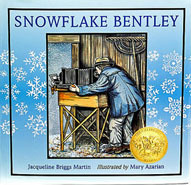
Check out this book about Wilson Bentley. His photos of snowflakes became world famous.
 What is it?!Look at the bottom of the blog to find out....
What is it?!Look at the bottom of the blog to find out....Treat The Birds

You can get a good look at birds that spend the winter in your neighborhood, if you invite them to dinner. An easy treat to make is a peanut butter pinecone. Loop a string around the top of a pine cone and tie a knot. Next, smear peanut butter on the cone and roll the cone in birdseed. Then have an adult partner hang the pinecone where birds will be able to perch and eat.
Now, keep watch. Use bird books and search on-line to help you identify the birds visiting your bird diner. Also, answer these questions:1. What time of day do the birds come to eat? 2. Do the birds come more on stormy or sunny days?3. Do the birds take turns and feed one at a time? Or do they compete to eat?4. Which birds usually chase other birds away?
Create a colorful bar graph to share the data you collect about your dinner guests.
Remember, to replace your pinecone with a fresh treat from time-to-time to keep the dinners coming back for more.
And when you're ready to warm up inside, curl up with one of my newest books.
Mystery-Adventure Middle Grade Novel
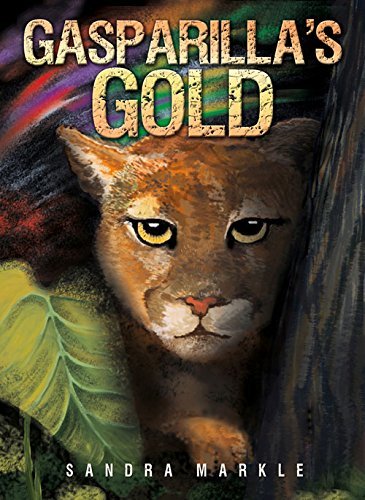
COMING SOON!
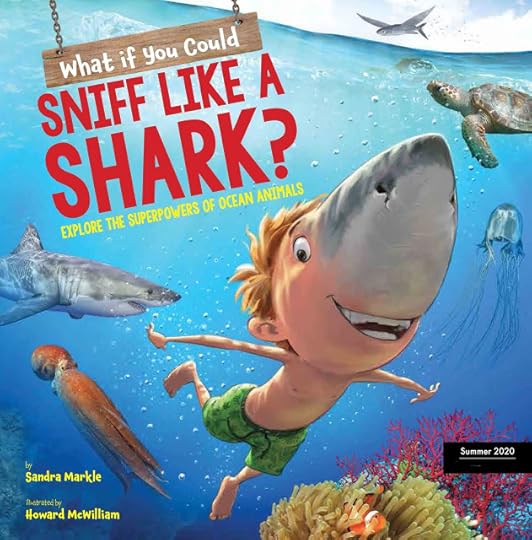
STILL FUN!
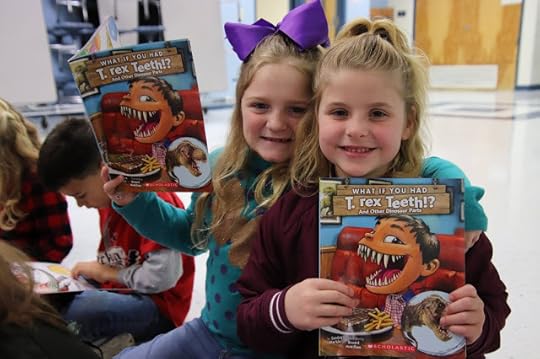
Do you know what this is?

It's a photo taken in the Antarctic of a cup of hot tea tossed into the air. The liquid was boiling hot but instantly froze into tiny crystals.
Published on November 27, 2019 06:45
November 12, 2019
OVERVIEW--HONORED!

WHAT A THRILL to share with Benjamin Grant in having our book OVERVIEW, A New Way of Seeing Earth, The Young Explorer's Edition honored by being chosen for Amazon's Best Books of the Year Nonfiction list.
If you haven't seen it, don't miss discovering Earth at its most amazing!
Published on November 12, 2019 19:09
November 5, 2019
WONDER! IMAGINE! DISCOVER! HAVE FUN!!!!

This month let children wonder WHAT IF I HAD ANIMAL EYES!?
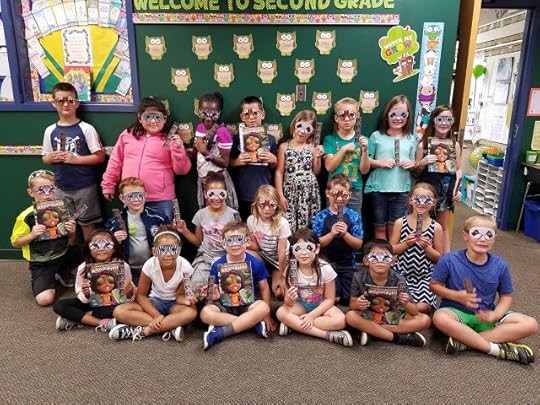
AND help them discover how special eyes help animals thrive where they live.
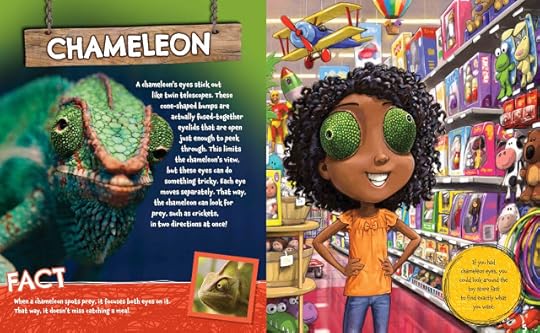
Chameleon Eye Spy
For this activity, scatter several objects to find around the classroom. Next, choose two students to team up. Have that pair stand side-by-side. Give each child in the team one empty toilet paper tube. (Or use paper towel tubes for an even bigger challenge.)
Have the team close their eyes while someone places three colorful objects, such as red apples, somewhere in the classroom.
Now, have each child use a hand to cover the eye on the side next to their partner. And hold the tube up to their uncovered eye. Only looking through the tubes, each member of the team can look in any direction. However, as soon as one team member spots an object that person must guide their partner to home in on the object. And together they must point out the object.
Then repeat to find the other object.
Let other teams try the challenge. Discuss how having eyes that can look in more than one direction is a useful adaptation. And why it's key that both eyes can also focus in the same direction.

Also share that chameleon bodies (feet and tail) are designed for getting a grip on their habitat and hanging on tight. Why might chameleons have different eyes if they could move their bodies quickly?
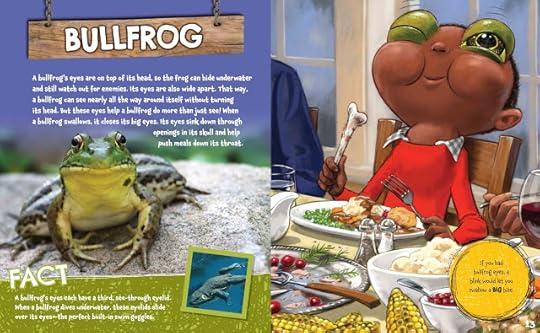
Bullfrog Eye Spy
Often, there's so many interesting facts it's tough to choose just what to share in the "What If You Had?!" info-burst. That was true for the Bullfrog. So here are some cool facts I didn't share:
*It's a good thing a bullfrog can see nearly all the way around itself because, unlike people, it can't turn its eyes in its head.
*Bullfrogs are nearsighted.
*Their eyes are extremely sensitive to movement. However, if prey, such as flies, don't move, a bullfrog doesn't see it.
Now, follow the directions on one the following resource sites to make periscopes. Then let children experience peeking over things to spy like a bullfrog.
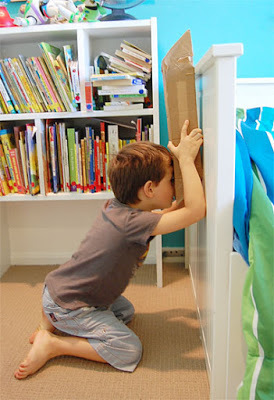
Have children write a short story or poem about being a frog hiding underwater while watching their world.
Making A Cardboard Periscope 1
Making A Cardboard Periscope 2
MORE FUN!
Once your class has read all the What If You Had?! books, have them create a picture of themselves with all the animal adaptations they wish they had.
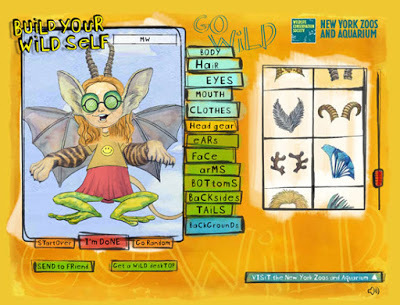
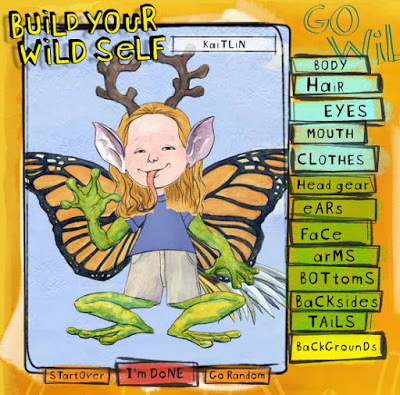
STILL MORE FUN!!
You and your students are sure to think of even more ways to have fun with WHAT IF YOU HAD ANIMAL EYES!?

Published on November 05, 2019 06:33
November 3, 2019
CHECK IT OUT!
Published on November 03, 2019 11:58
October 15, 2019
TAKE A BITE!
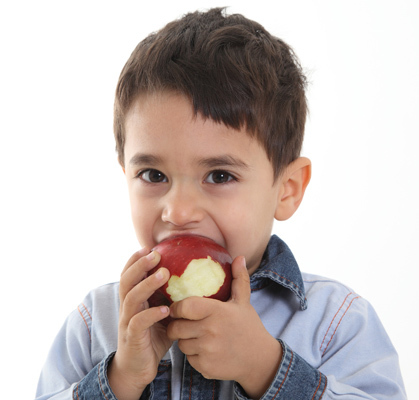
IT'S APPLE TIME!
I love this season! Whether you live where autumn brings lots of changes or only a few, it's still a great time for seasonal fun. So let's jump in and get started.
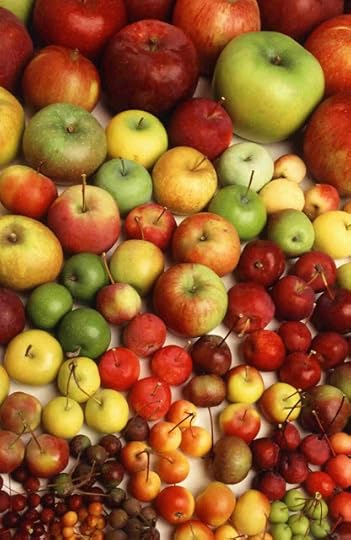 CHOMP!
CHOMP!There are thousands of kinds of apples. However, only the most popular are grown and harvested. Even that changes as new varieties emerge. Today, the top ten are most often listed as the following:
Pink Lady HoneycrispFujiGolden DeliciousMcIntoshCox's Orange PippinRed DeliciousGalaJonasgoldCortland
Collect samples of any three then compare.
Do the apples look different?
Check color.
Shape.
Size.
Now wash and slice. Then taste one sample. Rate it from 1 to 4 on crispness with 1 being the softest and 4 being the crispest.
Also rate it on sweetness with 1 being the least sweet and 4 being the sweetest.
It's estimated each person in the U.S. eats about 50 apples each year. So take a bite to be on your way to eating your fair share!

RIDDLE: What kind of fruit do ghosts like?
Boo-berries.

RIDDLE: What's a vampire's favorite fruit?
Neck-tarines.
SNAP IT UP

To bob for apples, fill a large plastic storage tub or child's plastic wading pool nearly full of water. Wash the apples--one for each contestant. Set these afloat. To play each person, in turn, bends over the tub with their hands behind their back. Have someone time each person working to snatch an apple in their teeth. The fastest snatcher wins. Only each person wins a tasty apple snack.
*Write a short story about a bobbing-for-apples contest.

RIDDLE: What kind of horses do ghosts ride?
Nightmares.
Published on October 15, 2019 10:43
October 3, 2019
MAKE MUSIC!

Kids love to make music!Making their own musical instruments is a great way to explore what creates sounds-- and what changes the pitch.

TOOT A TUNE:
Start by letting children explore how air vibrating produces sound. Then explore how varying the amount of vibrating air changes the pitch--how high or low the tone sounds.
What you need: plastic straw, scissors.
What to do:
1. Snip off one end of the straw to form a V-shape. Nip off the point. Flatten the cut end by pressing it against a table top with a thumbnail.
2. Blow on the V-shaped en of the straw. That acts like a reed in a wood wind instrument and make the air blowing through the straw vibrate. PRESTO! A sound.
3. Snip off the straw to change its length. Blow again to hear the new sound this makes.
Now, get together with a group of friends. Have each make a Next, make each a little shorter than the one before. And tape all five together so they are side-by-side.
Try making up a tune to play with your straw instrument that's a different length. Toot sounds together and one-after-the-other. Just for fun, make your own tunes.

MAKE WATER BELLS
Start by letting children explore how different amounts of air vibrating produces different sounds.
What you need: 3 glass quart jars, a metal spoon, water--food coloring just for fun.
What to do:
1. Fill one jar half full of water. Tap it with the spoon. It should make a deep sound. If it does not, add a little more water. Keep testing and adding a little more water till you hear a deep sound. This is Bell 3.
2. Fill the second jar a little less than half full. Tap it. The sound should be higher than the first jar. If it is not, pour out a little water. Keep testing and pouring till you the sound is a little higher than the deep sound. This is Bell 2.
3. Fill the last jar with just enough water to cover the bottom. Tap it. The sound should be higher than the other two jars. This is Bell 1.
You can play "Mary Had A Little Lamb" by tapping the jars in this pattern.
1, 2, 3, 2---1, 1, 1
2, 2, 2, ---1, 1, 1
1, 2, 3, 2---1, 1, 1
1, 2, 2, 1, 2, 3
Now, experiment. Make up your own music to play on your Water Bells.

STRETCH AND STRUM
This time, it's rubber bands that get air moving and make sounds.
Go as wild as you want to let kids make their own guitars. What counts is having different thickness--or differently stretched--rubber bands.
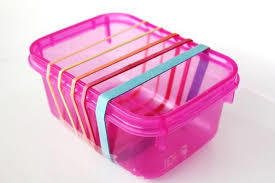 In fact, almost anything that will let you stretch the rubber bands will work!
In fact, almost anything that will let you stretch the rubber bands will work!What you need: cereal box, tape, scissors, BIG rubber bands--best to use different thicknesses. Or something, such as a pencil or crayon, to change stretch.
What to do:
1. Be sure cereal box is empty and tape top shut.
2. Cut a hole as big around as a drinking glass on just one of the flat sides of the box.
3. Stretch rubber bands over the box, across the hole.
Pluck the rubber bands to make sounds. Push the pencil or crayon under one or more of the rubber bands to change how much it's stretched. Check how that changes the pitch.
Here are some websites to explore for more musical instrument HOW-TO
GET kids being movers, shakers, and music makers!!!
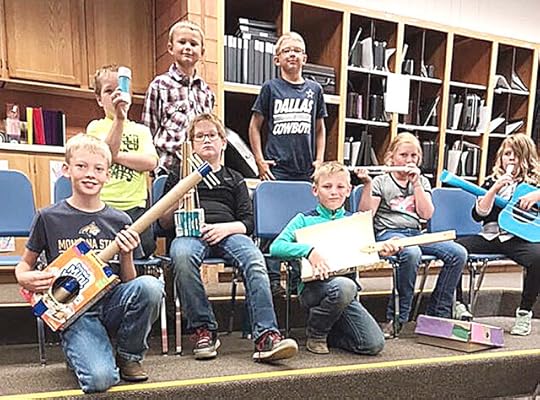
17 Handmade Instruments
Make Homemade Music with These 6 DIY Instruments
25 Musical Instruments Kids Can Actually Play
Published on October 03, 2019 08:50
SMILES AND CHEERS IN CHICAGOLAND!
What great school visits!check out the FUN!Next week I'm heading to Michigan for more science and reading time together!!!
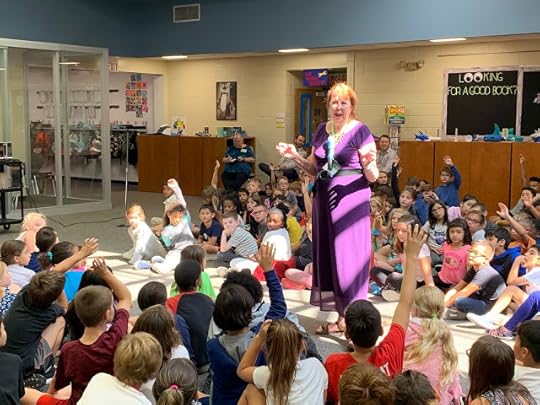

Published on October 03, 2019 08:39

